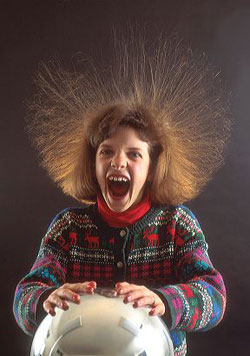干燥的季节里,脱毛衣时头发根根竖起;晚上,在黑暗中还会看到衣服摩擦产生的小火花……相信每个人都曾和“静电”过过招。那么,有趣的静电现象背后有着怎样的科学原理呢?你知道生活中哪些电器设备是受静电现象启发而发明的吗?

By Corey Binns
穆阳 选译
|
We’ve all have experienced static electricity in one way or another. Those unexpected little shocks we get when we touch a doorknob or some other metallic object, the balloons that stick to the wall after being rubbed in the head, or hair itself standing straight when it comes close, all are produced by static electricity. Most of the time it is produced when two objects come in contact or are rubbed together. What is Static Electricity? All materials are made up of molecules, and all molecules have tiny atoms, with positively charged protons, neutral neutrons, and negatively charged electrons. Most of the time an atom is neutral with the same number of protons and electrons. When an atom’s proton and electron numbers are uneven, the electron dance begins. If you place two different materials next to each other, electrons will start jumping from one material to the other. Static electricity is generated when any material gains or loses electrons and becomes positively (when it loses electrons) or negatively charged (when it gains electrons). The accumulated charges are what’s called static electricity. Conductive materials like metals and carbon hold onto their electrons tightly, whereas insulating materials, such as plastic, can be charged by friction because they easily gain or lose electrons. In 600 BC, the Greek philosopher Thales[1] observed that some combinations of materials have more potential to make sparks fly than others. Materials can be catalogued in order of their tendency to become charged, from positive to negative. The lower an item sits on the list, the more likely it will attract more electrons and become negatively charged. Rubbing objects far from each other on the list creates a bigger charge than objects closer together. For example, polishing a glass plate with a silk scarf electrifies the scarf so that it acts like a magnet. When you stride across a wool carpet in leather shoes, your shoes pick up extra electrons from the carpet with each step. By the time you lift your foot up off the ground, the electrons will have spread around your entire body, giving you a negative charge. The next time you put your foot on the carpet, your shoe doesn’t have any extra electrons, but your head might. So more electrons make the leap to your foot. “As you keep walking across the floor, you become full of electrons,” said Todd Hubing, from the Electromagnetic Compatibility Laboratory at the University of Missouri-Rolla. “Eventually more electrons don’t want to come up on you because you’re so charged up. You end up with a high voltage, about 20,000 to 25,000 volts.” That’s serious power at your fingertips, considering a normal electrical outlet on the wall is only around 100 volts[2] of electricity. Practical Uses of Static Charges Dust removal: There are some appliances that can eliminate dust from the air, like air purifiers. They use static electricity to alter the charges in the dust particles so that they stick to a filter of the purifier that has an opposite charge as that of the dust (opposite charges attract each other). This effect is also used in industrial smokestacks to reduce the pollution that they generate. The effect is basically the same as the home air purifier. Photocopy: Copy machines use static electricity to make ink get attracted to the areas where we need the information copied. It uses the charges to apply the ink only in the areas where the paper to be copied is darker (usually this means text or other information) and not where the paper is white, this process is called xerography. Car painting: To make sure a car’s paint is uniform and that it will resist the high speeds and weather to protect the car’s metal interior, it is applied with a static charge. The metal body of the car is submerged in a substance that charges it positively, and the paint is charged negatively. This process ensures a uniform layer of paint, since when there is enough negative paint in the car the extra will be repelled by the paint already in the car. It also ensures that the paint won’t fall off.
|
我们每个人都已通过各种不同的途径体验过静电。我们接触到门把手或其他金属物体时身上感到的那些不期而至的小电击,与头发摩擦后粘在墙上的气球,或是静电在附近时竖起的发丝,这些都是因静电产生的。大多数情况下,静电是在两个物体接触或互相摩擦时产生的。 什么是静电? 所有的物质都是由分子构成的,而所有的分子内都有微小的原子、带正电荷的质子、中性的中子和带负电荷的电子。大多数情况下,由于质子和电子的数量相等,原子呈中性。而当一个原子的质子和电子数不均衡时,电子便开始跳跃起来。如果你将两种不同的材料放在一起,电子就会开始从一种材料跳到另外一种上。 静电的产生是由于任何一种材料因得到或失去电子而变得带有正电荷(失去电子的情况下)或带有负电荷(得到电子的情况下)。这些累积的电荷就是所谓的静电。像金属和碳这样的传导性材料能把它们的电子紧紧抓住,而绝缘性的材料,如塑料,则可以通过摩擦带电,因为此类材料很容易得到或失去电子。 公元前600年,希腊哲学家泰利斯观察到一些材料的(特定)组合比其他组合更能产生四散的火花。各种材料按照从易带电到不易带电可以排列为从正到负的顺序。一件物品在这个表单的位次越靠下,就越容易吸引更多的电子而带负电。摩擦两个在表单上位列较远的物品,能比摩擦离得较近的物品产生出更大的电荷。例如,用一条丝巾擦一块玻璃盘子就会使丝巾带电,它可以起到磁铁的作用。 当你穿着皮鞋大步走过一块羊毛地毯时,每走一步,皮鞋就会从地毯上获得多余的电子。当你的脚向上抬起离开地面时,这些电子就会流散到你全身,令你带负电。接下来当你把脚又踩在地毯上时,鞋子上就不会再有多余的电子了,但你的头上可能会有。所以更多的电子就会跳向你的脚。 “当你继续走过地板时,全身就会充满电子,”密苏里大学罗拉分校电磁兼容实验室的托德•哈兵说。“到最后不会再有电子附上你的身体,因为你已经被充满了电。最后你会带有高电压,大约两万到两万五千伏。”这时你手上可带有不小的电力呢,想想墙上的一个普通插座才有大概一百伏的电。 静电的应用 吸尘器:有些电器能够去除空气中的灰尘,例如空气净化器。这些电器利用静电来改变灰尘颗粒中的电荷(极性),使它们附着在净化器上一块与灰尘颗粒所带电荷相反的过滤器上(极性相反的电荷相吸)。这种效应还被应用在工业烟囱上,以减少其产生的污染。其作用原理与家用的空气净化器基本上是相同的。 影印:影印机利用静电使油墨附着在我们需要复印信息的区域。它利用电荷将油墨仅附着在要复印纸张较深色的区域(通常较深色的区域就是文字或其他信息),而不是附着在纸的白色区域,这个过程就叫做静电复印。 汽车喷漆:为了保证汽车漆层的均匀一致,而且能够抵御高速行驶和各种天气条件的危害以保护汽车的金属内层,喷漆应用了静电原理。汽车的金属车身被覆上一种带正电荷的物质,而涂料则带有负电荷。 这一过程确保了漆层的均匀统一,因为当车上已有足够负电荷的油漆时,多余的漆就会被车身上已有的漆排斥。它同时保证了漆不会脱落。 (来源:英语学习杂志) |
|
Vocabulary: 1. Thales: 泰利斯(624?—546? BC),古希腊哲学家、数学家、天文学家,“希腊七贤”之一,认为水为万物本原,相传曾准确预测过公元前585年的一次日蚀。 2. 目前世界各国室内用电所使用的电压大体有两种,分别为100V—130V,与220—240V两个类型,采用前者的国家有日本、美国、加拿大等;而我国和许多欧洲国家则采用的是220—240V的电压。 |